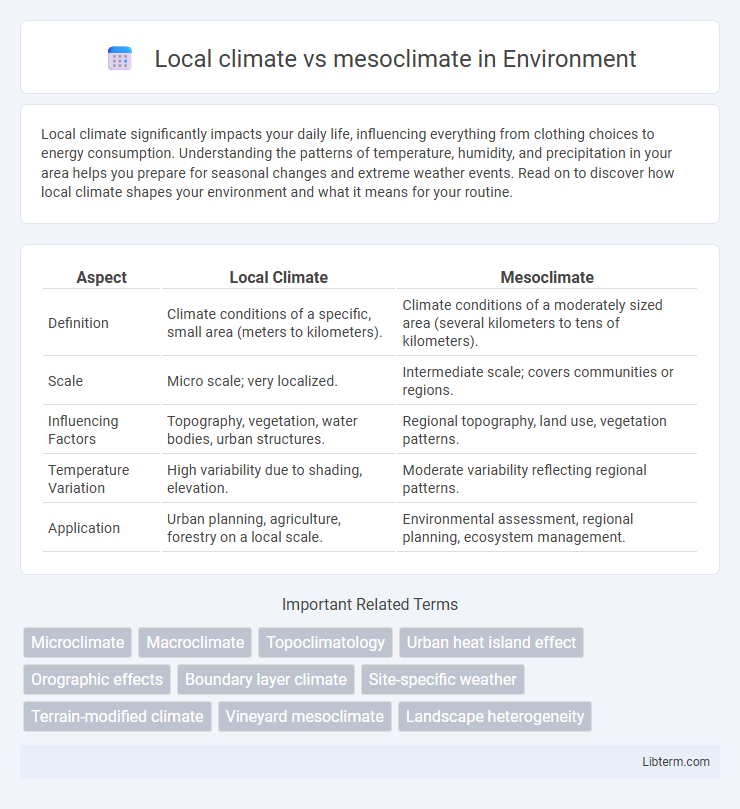Local climate significantly impacts your daily life, influencing everything from clothing choices to energy consumption. Understanding the patterns of temperature, humidity, and precipitation in your area helps you prepare for seasonal changes and extreme weather events. Read on to discover how local climate shapes your environment and what it means for your routine.
Table of Comparison
| Aspect | Local Climate | Mesoclimate |
|---|---|---|
| Definition | Climate conditions of a specific, small area (meters to kilometers). | Climate conditions of a moderately sized area (several kilometers to tens of kilometers). |
| Scale | Micro scale; very localized. | Intermediate scale; covers communities or regions. |
| Influencing Factors | Topography, vegetation, water bodies, urban structures. | Regional topography, land use, vegetation patterns. |
| Temperature Variation | High variability due to shading, elevation. | Moderate variability reflecting regional patterns. |
| Application | Urban planning, agriculture, forestry on a local scale. | Environmental assessment, regional planning, ecosystem management. |
Understanding Local Climate: Key Definitions
Local climate refers to the climatic conditions experienced within a small, specific area, often influenced by immediate surroundings such as buildings, vegetation, and water bodies. Mesoclimate describes the climate of a larger area than local climate, spanning neighborhoods to small regions, capturing variations caused by terrain, elevation, and land use patterns. Understanding local climate involves analyzing micro-scale factors that impact temperature, humidity, and wind patterns, differentiating it from mesoclimate's broader, moderate-scale climatic influences.
Mesoclimate Explained: Scope and Characteristics
Mesoclimate refers to the climate of a specific region that spans areas from a few square kilometers to several hundred square kilometers, positioned between broader macroclimates and smaller local climates. It is characterized by variations in temperature, humidity, wind patterns, and precipitation influenced by geographic features such as hills, valleys, and water bodies. Understanding mesoclimate is essential for agriculture, urban planning, and environmental management as it captures the micro-regional climatic differences not evident in broader climate zones.
Spatial Scale Differences: Local vs Mesoclimate
Local climate refers to atmospheric conditions experienced within a very small, specific area, such as a neighborhood or park, usually influenced by immediate surroundings like buildings or vegetation. Mesoclimate encompasses a broader spatial scale, spanning several kilometers to tens of kilometers, capturing variations caused by landforms, water bodies, and regional topography. Understanding these spatial scale differences is crucial for accurate climate modeling, urban planning, and ecological assessments.
Influencing Factors of Local Climates
Local climates are shaped primarily by factors such as topography, vegetation, and urban infrastructure, which influence temperature, humidity, and wind patterns on a small scale. Elevation and proximity to water bodies directly affect local temperature ranges and moisture levels, creating microclimates distinct from the broader mesoclimate of a region. Land use changes, including deforestation or urbanization, alter surface albedo and heat retention, further modifying the local climate conditions.
Primary Drivers of Mesoclimate Variation
Mesoclimate variation is primarily driven by factors such as topography, elevation, vegetation cover, and proximity to water bodies, which influence temperature, humidity, and wind patterns on a scale larger than local climates but smaller than regional climates. Slope orientation and landform features create microclimatic zones affecting solar radiation and air circulation. These drivers result in distinct climate variations within mesoclimate zones that impact local weather and ecosystem conditions more broadly than localized microclimates.
Interactions Between Local and Mesoclimatic Conditions
Local climate reflects the specific atmospheric conditions of a small area, influenced by factors such as topography, vegetation, and urban structures, while mesoclimate covers a broader scale including valleys, hills, or coastal zones with more uniform climatic patterns. Interactions between local and mesoclimatic conditions determine microclimates, where local features can amplify or moderate mesoclimate influences, affecting temperature, humidity, and wind patterns. Understanding these dynamic interactions is essential for accurate weather forecasting, agricultural planning, and managing ecological systems in diverse environments.
Case Studies: Local Climate vs Mesoclimate in Urban Areas
Urban areas exhibit significant differences between local climate and mesoclimate due to variations in land use, building density, and green spaces. Case studies in cities like New York and Tokyo reveal that localized heat islands raise temperatures by 2-5degC compared to surrounding mesoclimates, affecting energy consumption and public health. Detailed analysis of microclimate data demonstrates how street orientation, surface materials, and urban vegetation modulate temperature, humidity, and wind patterns within city neighborhoods.
Microclimate, Local Climate, and Mesoclimate: A Comparative Overview
Microclimate refers to the climate of a very small, specific area, such as a garden or a street corner, influenced by factors like buildings, vegetation, and soil. Local climate encompasses a broader region, often a town or city, characterized by average temperature, humidity, and precipitation patterns over time. Mesoclimate represents an intermediate scale, typically a few kilometers to tens of kilometers, where geographical features like hills or large water bodies strongly affect temperature and wind conditions, bridging the gap between microclimate and regional climate patterns.
Impact on Agriculture and Ecosystems
Local climate significantly influences agriculture and ecosystems by determining microenvironment conditions such as soil moisture, temperature variations, and wind patterns, which directly affect crop growth and species distribution. Mesoclimate, covering larger areas like valleys or hillsides, shapes regional biodiversity and agricultural practices by moderating temperature extremes and influencing water availability. Understanding the interplay between local climate and mesoclimate helps optimize crop selection, pest management, and conservation strategies for sustainable agricultural productivity and ecosystem resilience.
Implications for Climate Adaptation and Urban Planning
Understanding the distinctions between local climate and mesoclimate is crucial for effective climate adaptation and urban planning. Local climate refers to the climatic conditions in a very specific area, often influenced by factors like vegetation, buildings, and water bodies, while mesoclimate covers a larger spatial scale, such as neighborhoods or city districts, incorporating broader weather patterns and topography. Urban planners utilize mesoclimate data to design infrastructure resilient to heatwaves, flooding, and air quality issues, while local climate analysis informs micro-scale interventions like green roofs and shaded streets to mitigate urban heat islands.
Local climate Infographic

 libterm.com
libterm.com